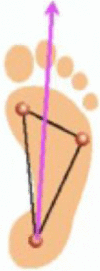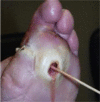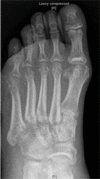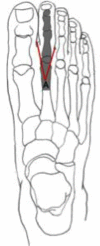Osteomyelitis in the diabetic foot
- PMID: 25147627
- PMCID: PMC4119293
- DOI: 10.3402/dfa.v5.24445
Osteomyelitis in the diabetic foot
Abstract
Osteomyelitis (OM) is a common complication of diabetic foot ulcers and/or diabetic foot infections. This review article discusses the clinical presentation, diagnosis, and treatment of OM in the diabetic foot. Clinical features that point to the possibility of OM include the presence of exposed bone in the depth of a diabetic foot ulcer. Medical imaging studies include plain radiographs, magnetic resonance imaging, and bone scintigraphy. A high index of suspicion is also required to make the diagnosis of OM in the diabetic foot combined with clinical and radiological studies.
Keywords: amputation; antibiotics; diabetic foot; infection; osteomyelitis; ulcer.
Figures







References
-
- Mutluoglu M, Sivrioglu AK, Eroglu M, Uzun G, Turhan V, Ay H, et al. The implications of the presence of osteomyelitis on outcomes of infected diabetic foot wounds. Scand J Infect Dis. 2013;45:497–503. - PubMed
-
- Game FL. Osteomyelitis in the diabetic foot: diagnosis and management. Med Clin North Am. 2013;97:947–56. - PubMed
-
- Ramsey SD, Newton K, Blough D, McCulloch DK, Sandhu N, Reiber GE, et al. Incidence, outcomes, and cost of foot ulcers in patients with diabetes. Diabetes Care. 1999;22:382–7. - PubMed
-
- Lavery LA, Peters EJ, Armstrong DG, Wendel CS, Murdoch DP, Lipsky BA. Risk factors for developing osteomyelitis in patients with diabetic foot wounds. Diabetes Res Clin Pract. 2009;83:347–52. - PubMed
-
- Newman LG, Waller J, Palestro CJ, Schwartz M, Klein MJ, Hermann G, et al. Unsuspected osteomyelitis in diabetic foot ulcers. Diagnosis and monitoring by leukocyte scanning with indium in 111 oxyquinoline. JAMA. 1991;266:1246–51. - PubMed
Publication types
LinkOut - more resources
Full Text Sources
Other Literature Sources
